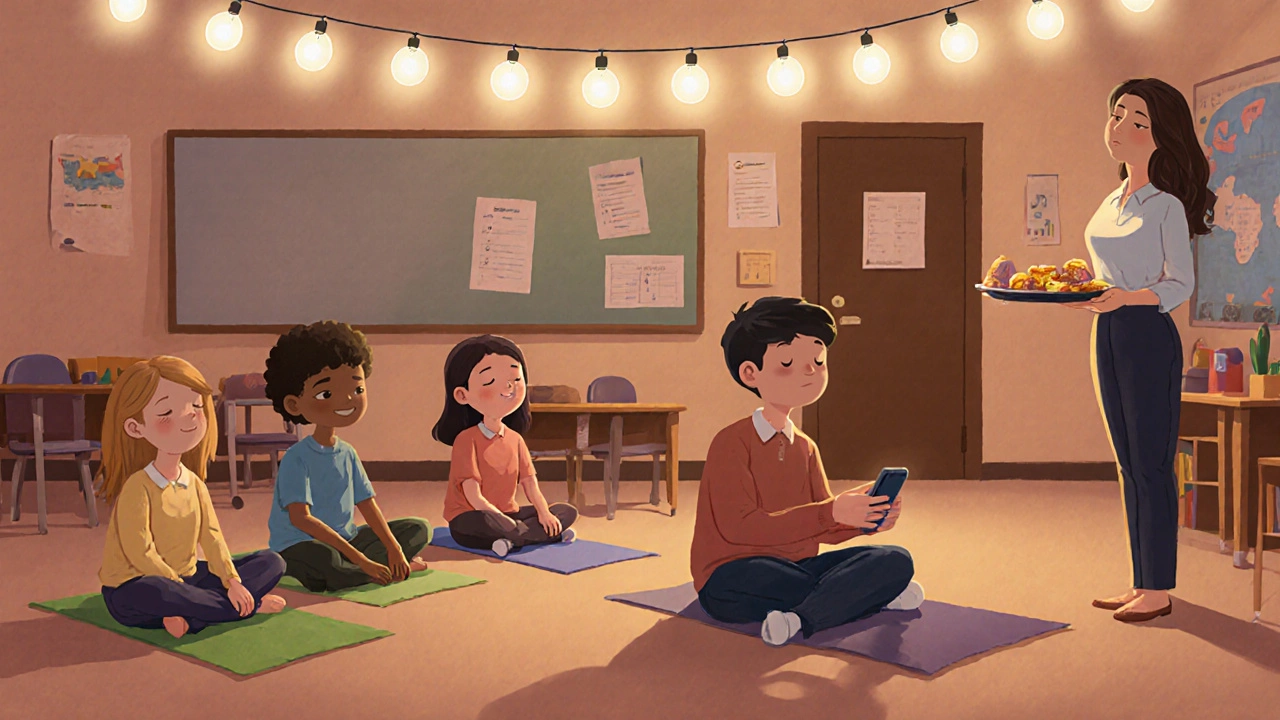Club Engagement Score Calculator
How well does your club follow the engagement principles?
Your Club Engagement Score
Most school clubs die quietly. They start with a burst of energy - a few excited kids, a teacher who believes in the idea, maybe a flyer taped to the lockers. But by week three, the meeting room is half empty. By month two, it’s just the organizer and one other person. Why? Because they didn’t build something people actually wanted to join.
Start with what students care about, not what adults think they should care about
Don’t launch a debate club because you loved it in high school. Don’t start a robotics team because you think it looks good on a resume. Ask students what they’re already talking about. Walk the halls between classes. Listen to the lunchtime chatter. Check the school’s social media groups. What are they obsessed with? TikTok trends? Video games? Mental health? Fashion? Anime? Pet adoption? Those are your entry points.
A school in Dunedin started a ‘Meme Club’ last year. It wasn’t about making funny images - it was about digital literacy, humor as communication, and student expression. Within six weeks, it had 80 members. Why? Because it felt like something real, not something assigned. The club now runs weekly meme contests, teaches basic graphic design, and even helped the school redesign its website with student-friendly language.
Make it easy to join - and easy to stay
Barriers kill interest. If students need to fill out three forms, get a parent’s signature, pay $20, and wait two weeks for approval, they won’t bother. Schools often add bureaucracy because they’re trying to be responsible. But responsibility shouldn’t equal friction.
Try this: Let students sign up with just their name and year level. No forms. No fees. No waiting. If you need a permission slip for an off-site event, collect it then - not before. Make the first meeting feel like a hangout, not a recruitment pitch. Bring snacks. Play a quick game. Let them talk. Don’t lead with rules.
And don’t forget the schedule. If your club meets on a Tuesday at 3:15 p.m., right after a big test, you’re competing with exhaustion. Try Friday afternoons. Or after lunch on Wednesdays. When students know they can show up, unwind, and do something fun without rushing off to another commitment, they’ll come back.
Let students run it - not teachers
Teachers are essential. But they shouldn’t be the face of the club. Students want to feel ownership. They want to make decisions. They want to be in charge.
Assign a staff advisor - someone who shows up, helps with logistics, and keeps things safe - but let students pick the name, plan the meetings, choose the activities, and even pick the snacks. A group of Year 9 students in Christchurch started a ‘Mindful Minutes’ club. They didn’t ask their teacher for permission to lead yoga. They just showed up with yoga mats, put on calming music, and invited anyone who wanted to sit quietly for 10 minutes. Within a month, it was the most attended club in the school. The teacher? They just made sure the lights were on and the door was unlocked.

Connect your club to something bigger
Students don’t join clubs just to pass time. They want to feel like they’re making a difference - even a small one. Link your club to a cause, a challenge, or a real-world outcome.
A club in Wellington turned their book swap into a ‘Books for Kids’ drive. They collected gently used books, wrapped them in colorful paper, and delivered them to a local early childhood center. They took photos. They posted them. Parents shared them. The club went from 12 members to 67 in two months.
Or try a skill swap: Students who know how to code teach others how to build a simple website. Students who knit teach others to make beanies for a homeless shelter. When a club has a purpose beyond itself, it becomes contagious.
Use what’s already working - social media
If your club isn’t on Instagram, TikTok, or even a simple class WhatsApp group, you’re invisible. Students don’t check the school newsletter. They don’t read the bulletin board. They scroll.
Create a simple account. Post a photo of the last meeting. Share a quote from a member. Show behind-the-scenes clips: the messy art room after a painting session, the laughter during a game night, the pride on someone’s face when they finished their first song on the guitar. Use hashtags like #SchoolClubLife or #[YourSchoolName]Clubs. Tag students (with permission). Let them repost.
One school in Hamilton started posting a weekly ‘Club Spotlight’ - a 30-second video of one member talking about why they joined. No scripts. No fancy editing. Just real voices. The videos got hundreds of views. New members started showing up saying, ‘I saw your video. I want to do that.’
Celebrate small wins - publicly
Don’t wait for a big event to celebrate. Celebrate every step. Someone learned to tie a knot in the knot-tying club? Post it. Someone wrote their first poem in the writing club? Read it aloud. Someone got their first 100 followers on the club’s TikTok? Applaud them.
Public recognition doesn’t mean trophies. It means saying out loud: ‘This matters.’ A simple ‘Well done, Maya - your playlist made the whole club feel more alive’ goes further than any certificate.
And don’t forget the quiet ones. The student who always shows up but never speaks? Thank them. ‘We couldn’t do this without you being here.’ That kind of recognition builds loyalty.

Be consistent - and be real
Students can smell insincerity from a mile away. If you say you’re going to meet every Wednesday and then skip two weeks because you’re ‘too busy,’ trust evaporates. Show up. Even if only three people come. Even if you’re tired. Even if the coffee machine is broken. Consistency builds safety. Safety builds belonging.
And don’t pretend you have all the answers. Say, ‘I don’t know how to fix this - what do you think?’ That’s how you turn a club from a project into a community.
What doesn’t work
Don’t force attendance. Don’t tie club participation to grades. Don’t make it competitive unless the students want it to be. Don’t copy what worked at another school - every group is different. What made the chess club explode at one school might flop at yours because the culture is different.
And don’t ignore the quiet kids. The ones who don’t post on social media, don’t raise their hands, and never speak up. They’re often the most loyal. Invite them one-on-one. Ask what they’d like to see. Sometimes, the most popular club starts with one shy student saying, ‘I wish we had something for people who just want to draw.’
It’s not about size - it’s about belonging
A club with 15 members who show up every week and laugh together is more powerful than a club with 100 who show up once and disappear. Focus on depth, not numbers. When students feel seen, heard, and safe, they’ll bring their friends. And when they bring their friends, the club grows - naturally, authentically, and sustainably.
Popularity isn’t about marketing. It’s about making space - for creativity, for connection, for being yourself.
What’s the fastest way to get students to join a school club?
The fastest way is to make joining feel effortless and the first meeting feel like a party, not a task. Skip the forms, bring snacks, play a quick game, and let students talk. If they leave thinking, ‘That was fun,’ they’ll come back - and bring friends.
Can a club be popular without social media?
Yes, but it’s harder. Word of mouth still works - especially if students are genuinely excited. Post flyers in high-traffic areas, have members invite their friends directly, and get teachers to mention it in class. But social media multiplies reach. Even a simple Instagram account with weekly photos can double attendance in a month.
How do I get teachers to support my club without taking over?
Be clear from the start: ‘We need you to help with space, supplies, and safety - not decisions.’ Give them a simple role: ‘You’re our logistics person.’ When they see students leading, they’ll step back. Most teachers want to empower students - they just don’t know how.
What if no one shows up to the first meeting?
Don’t panic. One or two people is a start. Talk to them. Ask what they’d change. Then go find others - walk the halls, ask classmates, check the school’s Discord or WhatsApp groups. Sometimes, the club just needs a second meeting to catch on. Keep showing up. Keep being welcoming. Momentum builds slowly.
Is it okay to start a club just for fun?
Absolutely. Some of the most popular clubs have no goal beyond connection. A movie night club. A snack-sharing group. A ‘chill zone’ after school. Students need space to just be. Fun isn’t a weakness - it’s the foundation of belonging.






